What To Do If You Found a Healthy Baby Mammal
Observe
A young animal’s best chance for surviving is with its parents. The first thing to do if you see a baby animal is to step away. You can assess the young animal from a distance. Many young animals appear to be abandoned. Oftentimes, their mother has not abandoned the young, but limits the number of visits to the nesting area to prevent predators from discovering its location. Humans are considered a predator and the parents will stay away while we are in the area. If the young look content and quiet, they are probably being well cared for and should be left alone.
Is it uninjured, furred and moving well?
If you find a baby mammal that is uninjured, is furred, and moving well, leave it alone, it will probably find its way back to a parent, or its parent will find it. If you see the nest, put on some gloves, and gently place the baby back in the nest. Despite the common misconception, wild animal parents will NOT reject babies if humans have touched them! A baby animal will always have the best chance for survival if it is raised by its parents.
Read more about what to do with a sick or injured mammal
Do you see its nest?
If you do not see the nest, you can create a surrogate nest to help keep the baby safe, and give the parents a chance to find them. You can place the animal in a plastic container, such as a laundry bin or Tupperware container, with holes poked in the bottom. Place natural bedding (soft grasses), or soft, 'non-stringy' bedding (try to avoid terry cloth or cloth that can unravel) in the container.
Learn more about making surrogate mammal nests
Determine if it is orphaned
Observe the baby and determine if it is orphaned. Follow the instructions below depending on the species
Opossum
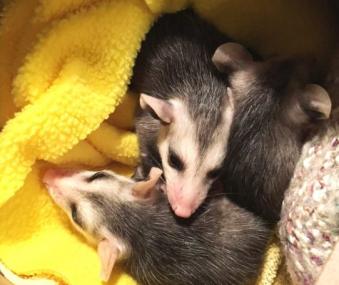
Baby opossums are born as embryos, barely larger than a bee, and spend about two months nursing in their mother’s pouch. When they get to be about 3-4 inches long and start riding around on the mother’s back, they may fall off without the mother noticing. As a general rule, if an opossum is over 7 inches long (not including the tail), he’s old enough to be on their own; if he’s less than 7 inches long (not including the tail), they are an orphan and appear to be healthy, you should contact a licensed wildlife rehabilitator.
If you know the parents are dead, contact a licensed wildlife rehabilitator to take the orphans.
Note! If the baby opossum are injured, follow these instructions.
Rabbit
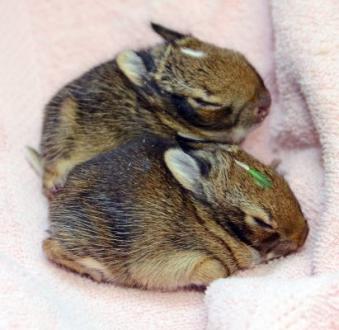
A rabbit who is 4 inches long, hops well and has open eyes and erect ears is independent from its mother and should be allowed to fend for itself. Uninjured baby rabbits in an intact nest should also be left alone. Although they might look abandoned because mom isn’t around, mother rabbits visit their dependent young only a few times a day to avoid attracting predators. Mother rabbits spend more time with the babies from dusk till dawn.
If the nest has been disturbed, lightly cover it with natural materials you find around the nest, like grass, fur or leaves, and follow these steps:
- Keep all pets out of the area.
- Avoid touching the babies.
- Use grass or twigs to make a tic-tac-toe pattern over the nest to assess whether the mother is returning to nurse the young. Check back 24 hours later.
- If the grass or twigs were moved aside but the nest is still covered with fur, grass or leaves, the mother has returned to nurse the babies.
- If the tic-tac-toe pattern remains undisturbed for 24 hours, you should contact a licensed wildlife rehabilitator.
Squirrel
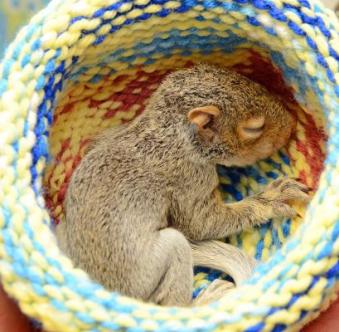
A squirrel who is nearly full-sized, has a full and fluffy tail and can run, jump and climb is independent. However, if a juvenile squirrel continuously approaches and follows people, then mom is probably gone. In this case, you should contact a licensed wildlife rehabilitator because the baby is very hungry and needs care.
There are a few cases where you might need to intervene:
- A baby squirrel falls from a nest
- A nest falls from a tree
- A felled tree contains an intact nest
- If the baby and/or their nest fell from the tree today, give the mother squirrel a chance to reclaim the young and relocate them to a new nest. If the baby is uninjured, leave it where it is, leave the area, keep people and pets away, and monitor it from a safe distance.
- If it’s chilly outside or the baby isn’t fully furred, place it in a shoebox or other small container with something warm underneath (like a hot water bottle). Be sure to place something soft (old towel, T shirt) between the baby and the heating device, or it could overheat. Do not cover it with anything or the mother might not be able to find it.
- If the babies are not retrieved by dusk, take these steps:
- Wearing thick gloves, gather the squirrel(s) and place them inside a thick, soft cloth, such as a cloth diaper or fleece scarf or hat.
- Place one of the following items beneath the cloth:
- a chemical hand warmer inside a sock,
- a hot water bottle (replace the hot water every 30 minutes) or
- a heating pad set on the lowest setting. (If the heating pad has no cover, put it inside two pillow cases so the babies don’t overheat.)
- If the baby squirrels are not sick or injured, place the baby squirrels, cloth and warmer inside a small cardboard box or carrier. Call a licensed wildlife rehabilitator.
Note! If the baby squirrels are injured, follow these instructions.
Fawn
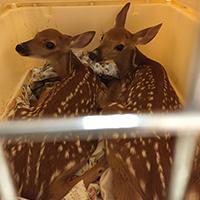
That Fawn is Likely NOT an Orphan
Each spring, MassWildlife receives reports from well-intentioned people who want to help a fawn that they found alone and thought was “orphaned”. However, it’s completely NORMAL for fawns to be left alone by their mother. It is the best thing the mother can do to protect her fawn. She is likely nearby watching you, but you probably won’t see her. The best thing YOU can do to help a fawn is to leave it alone. Enjoy the experience of nature, take a picture, but leave it there.
Mothers normally leave their babies alone while they forage for food. If the deer you found is a fawn, please determine first if it is truly sick or injured and not just “parked” by the mother. Find out more on the MassWildlife website.
We are providing links directly from the state deer biologist to provide the most current information.
If you have found a sick or injured fawn, do not attempt to handle or transport the fawn without local authorities. For further assistance on Transport, please refer to the "Who to Call for Help" section on this page.
Skunk
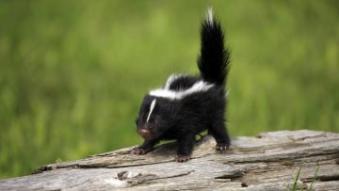
Caution: Rabies vector species. Always wear gloves when handling.
Orphan Alert: Be very careful not to create orphan skunks by accident. Mother skunks often give birth in the spring in and around our dwellings. When homeowners hire pest control companies to remove the mother, the babies will be left behind. The best solution is to let the family stay until the babies are old enough to take off on their own. Once you are sure the skunks have moved out, seal up their entry and exit. Remember, skunks dig for food, so make sure that when you block their entry, the barrier continues approximately 6 inches below the soil. Unnecessarily removing an animal from its environment – particularly a baby – can cause more harm than simply leaving it be. It is important to recognize signs of distress.
There are a few cases where you might need to intervene:
- The baby skunk is crying continuously (mewing sound like a kitten).
- The baby skunks eyes are closed and it is out of the den.
- The baby skunk is cold to the touch.
- The baby skunk is injured or has been attacked.
- The mother has been removed, relocated or is dead.
- There are flies around the baby skunk.
What to do if you find a baby skunk…
- Always wear gloves when handling skunks.
- You are not likely to get sprayed so long as the situation is kept calm.
- If the baby looks healthy, it is best to wait and watch until the evening before taking action. If there is no sign of the mother, or if the baby is injured or being stalked by a predator, or is in danger of wandering into a road, don’t wait.
If you know of an animal who needs help, please call your local animal control officer, a licensed wildlife rehabilitator, or the Tufts Wildlife Clinic as soon as possible.
Note! If the baby skunk(s) are injured, follow these instructions.
Woodchuck
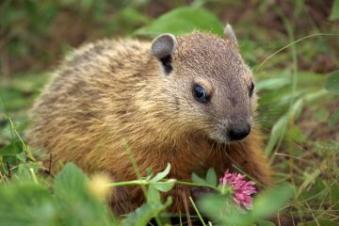
Caution: Rabies vector species. Always wear gloves when handling.
At birth, woodchucks are naked, blind and helpless and measure less than four inches long. A baby woodchuck opens its eyes when it is about 4 weeks old, but they seldom venture outside until they are between 6 or 7 weeks old.
There are a few cases where you might need to intervene:
- The baby woodchuck’s eyes are closed and it is out of the den.
- The baby woodchuck is injured or has been attacked.
- The baby woodchuck is lying stretched out and is cold to the touch.
- The mother has been removed, relocated or is dead.
- There are flies around the baby woodchuck.
If you know of an animal who needs help, please call your local animal control officer, a licensed wildlife rehabilitator, or the Tufts Wildlife Clinic as soon as possible.
Note! If the baby woodchuck(s) are injured, follow these instructions.
Raccoon
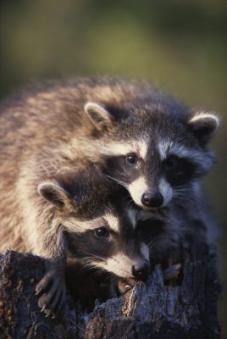
Caution: Rabies vector species. Always wear gloves when handling.
Orphan Alert: Be very careful not to create orphan raccoons by accident. When a baby raccoon is separated from its mother during the night, the baby will stay where it is until the mother returns, which may not be until the next night. People often find a sleeping baby raccoon and will assume it needs to be rescued. However, it is likely that the mother will be back after dark. If the baby raccoon is not in imminent danger, it’s best to observe the baby for another 24 hours without disturbing it. Unnecessarily removing an animal from its environment – particularly a baby – can cause more harm than simply leaving it be. It is important to recognize signs of distress.
There are a few cases where you might need to intervene:
- The baby raccoon has been crying continuously.
- The baby raccoon remains in the same spot for 24 hours.
- The eyes are closed and the baby raccoon is alone. (no mother)
- The baby raccoon is lying stretched out and is cold to the touch.
- The mother has been removed, relocated or is dead.
- The baby raccoon is injured or has been attacked.
- The baby raccoon walks up to humans non-aggressively.
- There are flies around the baby raccoon.
If you know of an animal who needs help, please call your local animal control officer, a licensed wildlife rehabilitator, or the Tufts Wildlife Clinic as soon as possible.
Note! If the baby raccoon are injured, follow these instructions.
Bat
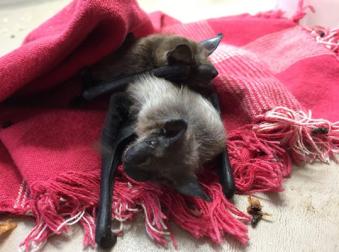
Caution: Rabies vector species. Always wear gloves when handling.
Unnecessarily removing an animal from its environment – particularly a baby – can cause more harm than simply leaving it be. It is important to recognize signs of distress.
There are a few cases where you might need to intervene:
- The bat pup is on the ground and its eyes are closed.
- The bat pup is cold or surrounded by flies.
- The bat pup is pink and has no fur.
- A female bat is on the ground with her pups attached to her.
- The bat pup is injured or has been attacked.
If you know of an animal who needs help, please call your local animal control officer, a licensed wildlife rehabilitator, or the Tufts Wildlife Clinic as soon as possible.
Note! If the baby bat(s) are injured, follow these instructions.